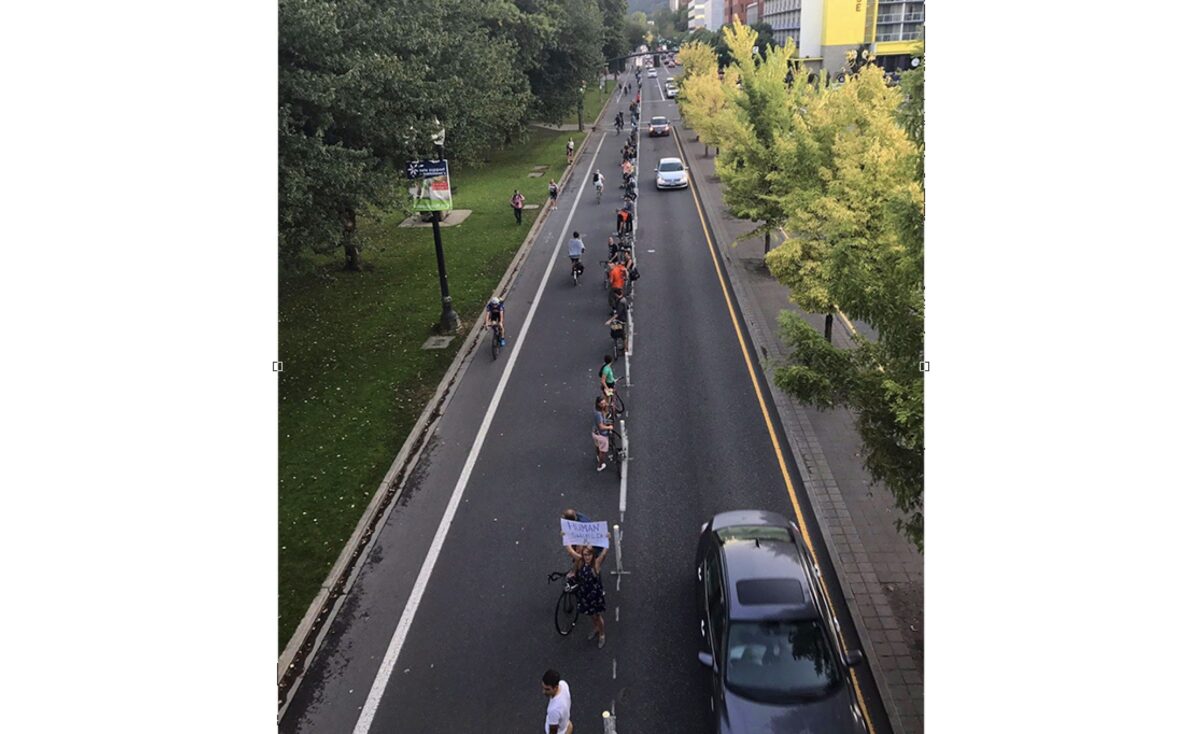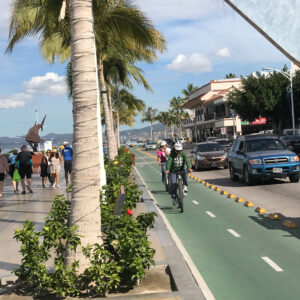
(Photo: Kiel Johnson)
By Kiel Johnson, owner and founder of Go By Bike, a bike shop and bike valet service located under the Portland Aerial Tram.
“Council continues the legacy of Governor McCall by taking another tiny sliver of our car dominated urban landscape and giving it back to the people.”
On October 7th Portland City Council approved a radical transformation of Naito Parkway, one of our most important streets. This change will make our city healthier, richer, more accessible, and more resilient to climate change. Naito will permanently go from four car lanes to mostly three, while allowing for a low impact vehicle lane for bicycles, scooters, and other ways of moving oneself that create joy.
With their “yes” votes, Portland City Council showed that the government combined with determined activism does work and can create systemic change. The news will not generate any front page stories, but for those eager to see that we can still do things together, it is worth noting and learning how we got here.
Seventy years ago most U.S. cities made a deal with the devil: They let centralized federal planning build freeways right through the heart of our cities. We traded social capital for automotive capital and with these new government built monuments to a carbon intensive economy, we became locked into a system where moving around took health and quality of life away for far too many.

As any good Portland tour guide will tell you, in 1974 our Republican governor was one of the first leaders to realize our mistake and do something about it. Tom McCall removed Harbor Drive and replaced it with the Waterfront Park after a group of activists began holding picnics between the highway lanes. For anyone who has been to Portland since 1974, it would be impossible to imagine our city without this park. It is where we gather to celebrate Cinco de Mayo, drink beer, listen to music, and where over 75,000 people once gathered to watch our first Black President speak.
Advertisement
But adjacent to Waterfront Park, Naito was left as a four car lane tribute to the past. With any good design you have to continue to adapt to the needs of the present. With their vote, council continues the legacy of Governor McCall by taking another tiny sliver of our car-dominated urban landscape and giving it back to the people.
Much like the push to transform Harbor Drive in the 1970s, this yes vote started with a group of activists making radical demands of their government. In 2015, a handful of young activists convinced the city to open the street up to people for two weeks in June. By the following year it was all summer, and as people got used to the new configuration it became all year. Now these changes will be fixed in cement.
For the past two years, hundreds of activists have staged an annual “human-protected bike lane” on Naito asking the city to make these changes permanent. Luckily they found a receptive ear from City Commissioner in charge of transportation – Chloe Eudaly. Commissioner Eudaly has taken the torch and led the charge to realize the vision through Better Naito Forever. These changes won’t expire at the end of each year and the cement separation will make it so a human wall is no longer necessary. As with the removal of Harbor Drive our success with Better Naito shows that a few determined activists combined with political leadership can change our lives for the better.
And this remains true: If enough people push hard enough, long enough, things start to change.
— Kiel Johnson, @Go_By_Bike
— Get our headlines delivered to your inbox.
— Support this independent community media outlet with a one-time contribution or monthly subscription.






Thanks for reading.
BikePortland has served this community with independent community journalism since 2005. We rely on subscriptions from readers like you to survive. Your financial support is vital in keeping this valuable resource alive and well.
Please subscribe today to strengthen and expand our work.
thank you to everyone who helped make this project possible. the world seems crazy right now and the passing of naito gives me hope that things will get better again. don’t give up!
Great message. We must persist!
Fascinating history. I absolutely agree! We can work together through advocacy and activism to encourage and build political will that our electeds and non-electeds in charge can use to improve the lot for all people who live our cities.
It’s not better. I have been utilizing this route, by bicycle, for longer than most of “you” have lived here. It’s not better and there is ALWAYS garbage now. Lot’s of garbage. Too bad this type of effort does not work for Forest Park.
I’m pretty sure the length of time that you personally were cycling this route doesn’t trump other people’s own personal experiences.
One would need a pair of glasses to not recognize the variety of items in these lanes. I’ve personally seen a rocking chair, a dumpster, and countless needles. Not a shot on those who put those items there, but they do exist.
Not sure how to interpret the quotes around “you”. Does that mean it’s a euphemism for something?
It’s a euphemism for “Californian” because “something something Californian high rent blah blah blah”.
Mran1984,
My family has been in Oregon before it was a state, and before bicycles with pedals even existed, and I think better Naito is great.
I’d like to see a count of who uses BN compared to the waterfront trail. I bet it’s close.
What would that tell you?
Probably what I already know.
What do you already know?
I’ve seen tube counters on Naito in the past. PBOT has the stats. I don’t know if they have bike counts for the waterfront trail, though.
See this 2018 BikePortland article that says that “people bicycling were twice as likely to ride Better Naito than the Waterfront Trail”. And the 2017 PBOT report that is the basis for the article.
The question then is – do we want twice as many people riding on the waterfront trail? I’d guess not. More options for cyclists with differing abilities, levels of comfort, and objections = better.
A “receptive ear” is quite different than an elected leader/advocate. I respect and appreciate the work that people have put into realizing the PBL on Naito. I also hope it does not give the impression that Chloe or PBOT has been a champion for change. My hope is that transportation safety advocates withhold their votes until a candidate declares their support for building a citywide network of protected bike lanes. Instead of settling for the least worst candidate, provide an acceptable minimum threshold that earns our votes.
Given the success of Better Naito, y’all might want to pursue tactics that don’t solely rely on elected city councilors and dithering PBOT leadership to get important stuff done.
I hear you David. Portland does not lack advocates. It does not lack for demonstrations (eg E Broadway, 4th). IMO it lacks political leaders, a solid money-backed safety-oriented advocacy nonprofit (eg Transalt in NYC), and cohesion. There are alot of people who bike and still believe in urban vehicular cycling. It’s one of those religions that hasn’t died off yet.
Looking at the Portland Bicycle master plan, I’d say that Portland also lacks a cohesive vision of what exactly the bike community wants (or wanted when it was passed). Not only were protected bike lanes and intersections missing from the plan, but SW and East Portland were deliberately under-evaluated. I see no big ideas in the plan, just a large collection of minor upgrades, which is essentially what PBOT has been doing ever since.
Exactly why I mentioned “vehicular cycling.” It is bewildering to me how many people who bike are against PBLs on simple, ego-centric, and anecdotal experience.
In most of the communities I’ve lived in (Portland being a major exception), those who drive and bike for recreation tend to be most tolerant of poor on-street infrastructure but most insistent for off-street paved bike paths, the most expensive (and least effective) type of bike infrastructure, as well as rural paved shoulders. Those who bike for transportation, whether they drive or not, seem to prefer painted bike lanes everywhere, even on low-volume streets that don’t need them and on fast arterial streets where they are dangerous to have. I’ve met very few cyclists that have ever used PBLs or even BBLs – I often find myself having to explain what they are, what kinds of roads they are most appropriate for, etc. I still find it amazing how few cyclists visit other cities and observe the infrastructure there, especially in innovative cities like DC, NYC, Chicago, or Seattle, or even overseas. I meet cyclists who have gone to such cities, but they somehow never observed the infrastructure there – they are of course driving their cars everywhere during their visits and literally don’t see what they are not looking for.